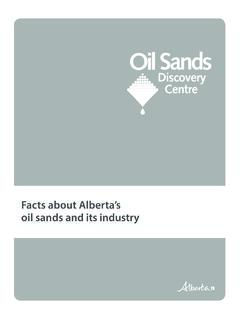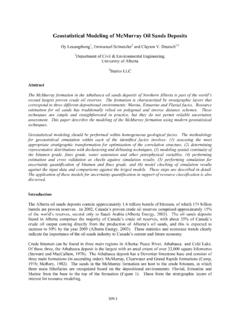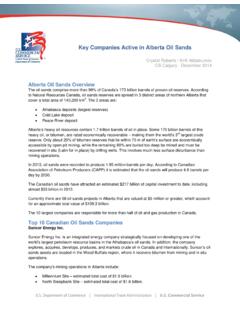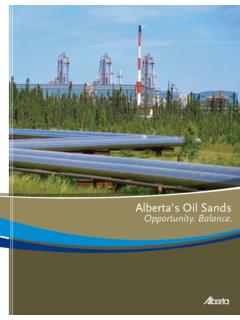Transcription of GOVERNMENT OF ALBERTA
1 FOR DISCUSSION GOVERNMENT OF ALBERTA Mineable Oil Sands Strategy NEED FOR POLICY ALBERTA s oil sands are essential to a secure North American energy supply. The industry has grown substantially over the last five years, with production output now in excess of one million barrels per day. Production has the potential to double within the next five to seven years, and triple by 2020, if proposed developments proceed. Most of the area suitable for oil sands mining in Northern ALBERTA will be proposed for, or under, development within the next decade. The GOVERNMENT of ALBERTA uses an integrated approach to development of natural resources so environmental, social and economic issues are considered. Policies and strategies developed in consultation with Albertans guide public and private actions that contribute to sustainable resource and environmental management.
2 As development proceeds, a shift in the pattern of development on the landscape is occurring, from single projects separated by forest and forest land uses, to broad coverage of the mineable area by industrial activity, with several projects under development at the same time. This policy sets realistic expectations for the coordinated development of projects and for the coordination of mineable oil sands development as a whole with regional sustainable development goals. These expectations will provide greater certainty for regulators, industry and the public, which will reduce conflict and refocus our collective efforts. SCOPE OF POLICY This policy addresses oil sands mine development and environmental management. These areas are the direct responsibility of three ministries Energy, Environment, and Sustainable Resource Development.
3 This policy will also have implications for other ministries with direct responsibility for socio-economic development, infrastructure and Aboriginal people. This policy will supersede the Fort McMurray Athabasca Oil Sands Subregional Plan for the mineable oil sands area. Within the Mineable Oil Sands boundary, this policy supersedes portions of the following Resource Management Areas (RMAs) in the Fort McMurray-Athabasca Oil Sands Subregional Integrated Resource Plan (IRP): Athabasca - Clearwater* Mildred - Kearl Lakes Stony - Birch *Exception - Mining operations within the McClelland Lake Wetlands Complex portion of the Athabasca Clearwater RMA, as amended in 2002, will continue to be managed under the direction of the RMA guidelines established in the IRP following public and Aboriginal consultation.
4 Any amendment to the IRP or this policy, which changes the resource management direction in the McClelland Lake Wetlands Complex (as indicated on the attached map) will be referred to Cabinet for review and approval after public consultation. Page 1 October 2005 FOR DISCUSSION POLICY GOAL ALBERTA achieves full value from the mineable oil sands through continued development, while returning disturbed areas to self-sustaining boreal forest ecosystems and sustaining the adjacent regional environment. POLICY COMPONENTS 1. The mineable oil sands area will be managed as a coordinated development zone. 2. Within the coordinated development zone, oil sands mining will have the highest priority. 3. The activities within the coordinated development zone will be constrained to sustain the adjacent regional environment.
5 4. Within the coordinated development zone there will be progressive, timely and seamless reclamation to a self-sustaining boreal forest ecosystem. 5. The environmental liabilities from oil sands mining will not be passed on to future generations. 6. Both existing and new operators will be expected to continuously improve their technology and methods. Page 2 October 2005 FOR DISCUSSION Figure 1. Mineable Oil Sands Boundary Page 3 October 2005 FOR DISCUSSION POLICY DETAILS 1. Mineable Oil Sands Area - The mineable oil sands area will be managed as a coordinated development zone. This policy shifts from current project level management to zonal level management for mineable oil sands. The map of the coordinated development zone of the mineable oil sands area is illustrated in Figure 1.
6 In the development zone, operators should coordinate development projects so that: o infrastructure is shared; o water is managed throughout the zone to optimize resource recovery, water use and to maintain the Athabasca River o compatible developments on the same lands can occur in a timely manner; o mine activities, reclaimed landscapes and reclaimed watersheds are topographically coordinated and functional across lease boundaries; o resource recovery is optimized; and o the area of surface disturbance is reduced, when it is feasible to do so. GOVERNMENT agencies will lead a partnership effort to plan efficient and coordinated development in the zone. Operators will work together and cooperate with regulators to manage development and reclamation activities. GOVERNMENT agencies will harmonize their plans, standards, and expectations to produce an efficient and understandable planning and regulatory system.
7 The coordinated development zone includes existing mineable oil sand resources and may be adjusted to include new mineable areas or exclude areas based on oil sands resource economics of mining or other factors in the future. Deputy Ministers may make minor amendments to the map. The Athabasca River setback will be determined by regulators based on the value of the oil sands resource and the objectives established in the IRP considering the holistic nature of the river valley. 2. Priority on Oil Sands - Oil sands mining will have the highest priority within the coordinated development zone. This policy shifts from managing all resources in the mineable oils sands area with equal weight to placing higher priority on extracting mineable oil sands. Any part of the development zone, excluding areas on the map that are not part of the development zone, is available for mining.
8 O The co-production and exploitation of other resources such as harvestable timber and aggregate resources is encouraged, in a manner compatible with oil sands mining and subject to the priority of oil sands mining in the development zone. Page 4 October 2005 FOR DISCUSSION o Processing oil sands products and by-products to increase their economic value is encouraged in the development zone, and within the region. GOVERNMENT will use existing compensation mechanisms to address existing mineral rights. GOVERNMENT will apply these legal mechanisms if GOVERNMENT abolishes existing mineral rights. Compensation in the form of timber damage assessments (TDA) will continue to be paid by oil sands operators when land is removed from the land base supporting local and regional forest industries. Forest industries or a delegated authority will receive the compensation.
9 GOVERNMENT will ensure the funds are directed to the goal of ensuring sustainability of the industry through sustainable wood supply from crown lands The development zone will be managed recognizing oil sands mining as the priority resource use. Specific conditions related to the protection of wildlife habitat within the development zone will not be implemented prior to or during oil sands mining. To ensure current and future generations continue to enjoy wildlife resources, habitat and population objectives will be achieved within a regional and provincial context through regional and provincial programs. Management strategies will place a greater emphasis on other habitat locations at a regional and provincial scale in order to maintain viable caribou populations, recognizing that the locations of the best habitat will change over time.
10 As reclamation is completed, public lands management priorities will shift to manage for wildlife and other resources. Public recreational access will be addressed through land use planning and focused on areas outside of the development zone. Access to portions of the development zone for traditional uses may also be limited during mining and the availability of meat, fish, fur, and plant materials will be reduced until the land is reclaimed. Within the development zone, air quality expectations will be the same as the surrounding region. 3. Regional Stewardship - Activities within the coordinated development zone will be constrained to sustain the adjacent regional environment. This policy elaborates on stewardship expectations after the shift from project level management to zonal level management.



















